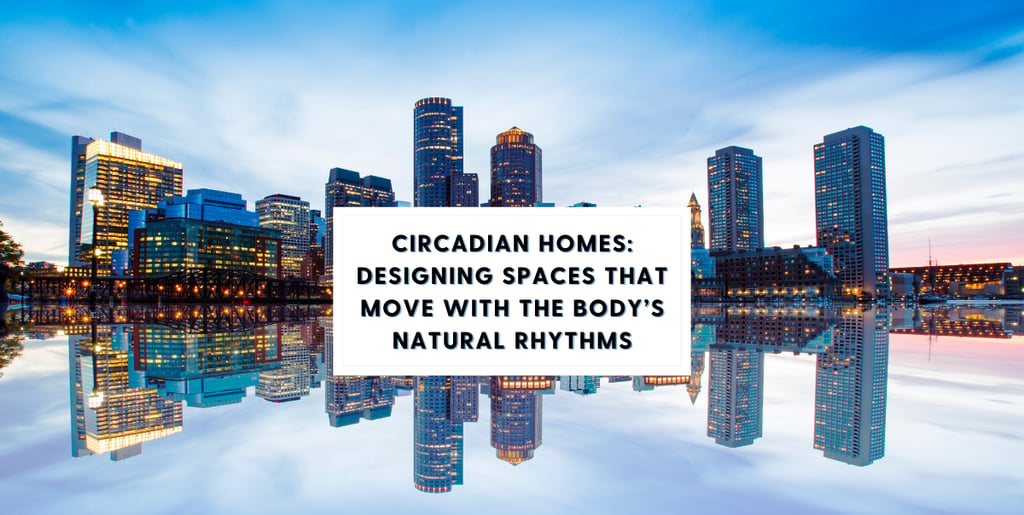Circadian Homes: Designing Spaces that Move with the Body’s Natural Rhythms
Discover how circadian homes are transforming real estate design. Learn how natural light, smart tech, and biophilic design create healthier, more balanced living spaces.
REAL ESTATE
Asad Ali
11/5/20255 min read


Introduction: Where Real Estate Meets Well-Being
Modern real estate has entered a new era — one where design isn’t just about luxury, but about how it makes us feel, perform, and live. In today’s fast-paced world, our connection with nature and time has weakened, leaving many people tired, stressed, and disconnected.
That’s where circadian homes come in — living spaces designed to move in sync with the body’s natural rhythms. These homes adapt to your body’s internal clock, using smart lighting, airflow, and materials that promote better sleep, mood, and productivity.
The concept is transforming architecture and development across the globe — and is becoming one of the most exciting innovations in Dubai’s real estate market.
What Are Circadian Homes?
A circadian home is designed around your body’s 24-hour biological clock, known as the circadian rhythm. This rhythm controls how alert, tired, or focused we feel throughout the day, depending on exposure to light and darkness.
Circadian homes aim to balance light, temperature, and air quality to help the body stay in tune with nature — even in an urban environment.
In simple terms, it’s about making your home work with your body instead of against it. From sunrise-inspired lighting that wakes you up naturally to warm evening tones that calm you before bed — circadian design makes your living space feel alive and restorative.
The Science Behind Circadian Living
The human body relies on natural light to regulate hormone production. In the morning, exposure to bright light triggers the release of cortisol, boosting energy and alertness. As night approaches, light fades, prompting the release of melatonin, which prepares the body for sleep.
However, artificial lighting, long work hours, and digital screens disrupt this cycle, leading to insomnia, fatigue, and mood swings.
That’s why circadian design has become a key trend in wellness-based real estate. Through smart technology and thoughtful architecture, these homes mimic nature’s rhythm — offering better sleep, focus, and overall health.
Core Elements of Circadian Home Design
Circadian homes combine science, architecture, and technology to create human-centered environments. Here are the key principles that make them work:
1. Natural Light Orientation
Proper sunlight exposure is the foundation of circadian design. Homes are positioned to capture morning light from the east and limit harsh afternoon rays. Windows, skylights, and glass panels are strategically placed to maximize daylight.
2. Smart Lighting Systems
These homes use automated lighting that changes color and brightness throughout the day. Cool white tones in the morning help with focus, while warmer amber tones in the evening help the body wind down naturally.
3. Temperature Regulation
Advanced HVAC systems adjust indoor temperatures according to time and body rhythm — cooler during the night for better sleep and warmer in the morning to wake the body naturally.
4. Biophilic Design
Circadian homes use natural materials like wood, stone, and bamboo, along with indoor plants and water features. These elements improve air quality, reduce stress, and create a strong connection with nature.
5. Acoustic and Material Balance
Soft textures and sound-absorbing materials help maintain peace and comfort. This allows your home to support focus during the day and calmness at night.
A Day Inside a Circadian Home
Let’s imagine living in a circadian home in Dubai — where smart design meets daily life.
6:30 AM:
Your lights gently brighten to a warm sunrise glow. The curtains open automatically, letting in natural light that tells your body it’s time to wake up.
10:00 AM:
Cool daylight floods your workspace, keeping you focused and productive. The indoor air adjusts to optimal oxygen levels to keep your mind fresh.
5:00 PM:
The lighting softens, temperature cools slightly, and the energy in your home starts to calm — just as your body prepares for rest.
9:30 PM:
Your living room glows with a soft amber hue, encouraging melatonin release. Your body relaxes naturally — no harsh lights, no overstimulation.
This rhythm enhances every moment of your day, helping you sleep deeper, work smarter, and live healthier.
Why Circadian Homes Are the Future of Real Estate
In cities like Dubai, where innovation and wellness are redefining modern living, circadian homes are emerging as the future of property design.
Homebuyers today want more than luxury — they want homes that enhance their health and lifestyle. Circadian design offers both, combining technology, sustainability, and comfort.
Benefits for Homeowners
Better Sleep: Lighting and temperature follow natural cycles, helping regulate sleep patterns.
Improved Productivity: Natural light boosts focus and creativity.
Energy Savings: Smart systems reduce unnecessary energy use.
Mental Well-Being: A balanced environment lowers stress and anxiety.
Benefits for Developers
Higher market demand for wellness-driven homes
Increased property value and resale potential
Positive brand image for promoting sustainability
Competitive edge in the luxury real estate market
In short, circadian design isn’t just a feature — it’s a lifestyle investment.
Dubai Real Estate: A Leader in Circadian Design
Dubai has always been a global leader in adopting futuristic concepts in architecture and urban development. The city’s developers are now embracing circadian architecture as part of its sustainable real estate movement.
Communities like The Sustainable City, Ellington Properties’ wellness residences, and Meydan Horizon are already integrating daylight simulation, energy-efficient smart systems, and biophilic materials into their projects.
As Dubai continues to focus on sustainability and innovation, circadian homes are becoming a symbol of the next generation of smart living — where luxury meets science and technology supports well-being.
How Circadian Design Adds Value to Real Estate
For investors and developers, circadian design offers both human and financial rewards.
1. Increased Property Value
Wellness-focused homes command higher prices because buyers associate them with quality and long-term health benefits.
2. Energy Efficiency
Homes that align with natural light reduce dependence on artificial lighting and air conditioning — lowering energy costs and supporting eco-friendly initiatives.
3. Emotional Appeal
Buyers increasingly seek homes that feel right — emotionally and physically. Circadian homes build a stronger connection between residents and their environment.
4. Future-Proof Investment
With global trends moving toward sustainable and smart living, circadian design ensures long-term property relevance.
Global Examples of Circadian Architecture
Developers worldwide are incorporating circadian principles into their projects:
The Edge (Amsterdam): Known for its daylight-optimized architecture and smart lighting systems.
Delos Wellness Homes (New York): Features circadian lighting, purified air systems, and biophilic design.
Dubai Hills Residences (UAE): Incorporates dynamic lighting and natural material interiors to enhance mental and physical well-being.
These projects prove that the demand for human-centric design is not a passing trend but a movement shaping the future of living spaces.
Challenges and The Future Ahead
While the concept is promising, circadian homes face a few challenges. The initial installation cost of smart systems and low public awareness are barriers. However, as technology becomes cheaper and sustainability gains importance, circadian design will become more mainstream.
In the coming years, we’ll see:
AI-based systems that personalize light and temperature schedules
Voice-integrated lighting connected with health apps
Real-time wellness data tracking for homeowners
The combination of AI, IoT, and design psychology will create homes that not only look good but actively support our health and happiness.
Conclusion
Circadian homes mark a major step forward in the real estate industry, merging architecture with human biology. These homes create a rhythm between people and their environment, enhancing wellness, productivity, and sleep.
For developers, they represent the future of smart and sustainable housing. For residents, they offer harmony, health, and a lifestyle that feels truly natural.
As cities like Dubai continue to evolve, circadian architecture will define a new era of intelligent living — where homes don’t just shelter us, they heal us.
The future of real estate is not just smart — it’s human.
